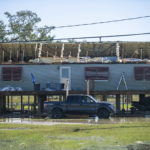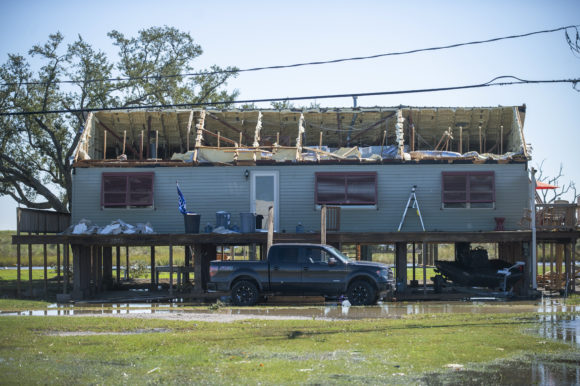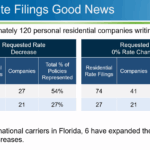A fast-moving Zeta weakened to a tropical storm as it barreled northeast on Oct. 29 after ripping through Louisiana and Mississippi where storm-weary residents were advised to stay indoors overnight while officials assessed the havoc the storm had wrought. The storm has been blamed for six deaths so far, one each in Alabama, Louisiana and Mississippi, and three in Georgia.
The storm raged onshore in the afternoon on Oct. 28 in the small village of Cocodrie in Louisiana as a strong Category 2 and then moved swiftly across the New Orleans area and into neighboring Mississippi, bringing with it both fierce winds and storm surge. There was heavy rain at times but since the storm was so fast-moving, rain related flooding wasn’t as much of a concern.
Zeta weakened over central Alabama but its strong winds continued across portions of the state and the Florida Panhandle. The storm was about 65 miles (104 kilometers) west northwest of Atlanta, Georgia, with maximum sustained winds of 60 mph (96 kph). Zeta is moving quickly toward the northeast at 39 mph (62 kph).
Before dawn millions of customers across Louisiana, Mississippi, Alabama and Georgia were without power, according to the website PowerOutage.us.
In Louisiana, Gov. John Bel Edwards was expected to tour the coastal regions hardest hit by the storm. During a radio interview Wednesday evening, Edwards said the wind had caused extensive structural damage. And as neighbors and church groups started reaching out to help those affected, he also highlighted the need to protect against the coronavirus at the same time.
“Offer the help but do it with a mask on,” he said.

The storm packed a punch as it whipped through New Orleans. Signs outside bars and restaurants swayed back and forth in the wind and palm trees along Canal Street whipped furiously. Officials said a person was hospitalized with minor injuries after a structure collapsed.
The latest punch from a record hurricane season left people shaken. Will Arute said it sounded like a bomb went off when part of a large oak snapped outside his home in New Orleans, and part of the tree crashed into his car and a corner of his home.
“I did not anticipate this to happen. It was pretty intense along the eye wall when it went through here,” he said.
More than 200 trees were reported down in the city. Echoing a plea made by officials across the Gulf Coast in the dark hours after the storm passed, New Orleans Mayor LaToya Cantrell implored residents to stay home and let city officials assess the damage.
“Although we have made it through, we have been damaged, we have been hit,” she said.
Along coastal Louisiana, there were reports of some trailers flipped over, a gas station destroyed, and downed power lines and trees.
Zeta had top sustained winds of 110 mph (177 kph) as a Category 2 hurricane at landfall and is the 27th named storm of a historically busy Atlantic hurricane season — with over a month left to go. It set a new record as the 11th named storm to make landfall in the continental U.S. in a single season, well beyond the nine storms that hit in 1916.
Zeta weakened to a Category 1 hurricane with winds of 90 mph (144 kph) as it moved into southern Mississippi a few hours after landfall.
New Orleans was in the warning areas of six previous storms that veered east or west this season. This time, Zeta stayed on course. Officials had been worried about the loss of a power from a turbine that helps power the city’s aging drainage infrastructure and whether that would leave the city vulnerable to flooding but Zeta’s swift movement meant flooding wasn’t an issue.
On Tuesday, Zeta raked across Mexico’s Yucatan Peninsula, toppling trees and briefly cutting power to more than 300,000 people but causing no deaths.
It then regained strength over the Gulf of Mexico along a path slightly to the east of those of Hurricane Laura, which was blamed for at least 27 deaths in Louisiana in August, and Hurricane Delta, which exacerbated Laura’s damage in the same area weeks later.
An average season sees six hurricanes and 12 named storms. This extraordinarily busy season has focused attention on climate change, which scientists say is causing wetter, stronger and more destructive storms.
And the fact that so many of the storms have been concentrated in such a small piece of Gulf Coast real estate has meant repeated damage for some places.
Topics Catastrophe Louisiana Hurricane Georgia Alabama Mississippi
Was this article valuable?
Here are more articles you may enjoy.



 General Mills Changing Nature Valley Labels After Lawsuit’s Herbicide Claim
General Mills Changing Nature Valley Labels After Lawsuit’s Herbicide Claim  Slide’s Exec Pay Leads to Questions About Florida Citizens’ Rate Model
Slide’s Exec Pay Leads to Questions About Florida Citizens’ Rate Model  Supreme Court Dealt Blows to EPA and Environmental Protections
Supreme Court Dealt Blows to EPA and Environmental Protections  Two More Insurers Enter Florida Market as Hurricane Season Warms Up
Two More Insurers Enter Florida Market as Hurricane Season Warms Up 

